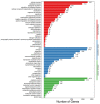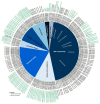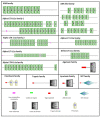De Novo Transcriptome Analysis of the Venom of Latrodectus geometricus with the Discovery of an Insect-Selective Na Channel Modulator
- PMID: 35011282
- PMCID: PMC8746590
- DOI: 10.3390/molecules27010047
De Novo Transcriptome Analysis of the Venom of Latrodectus geometricus with the Discovery of an Insect-Selective Na Channel Modulator
Abstract
The brown widow spider, Latrodectus geometricus, is a predator of a variety of agricultural insects and is also hazardous for humans. Its venom is a true pharmacopeia representing neurotoxic peptides targeting the ion channels and/or receptors of both vertebrates and invertebrates. The lack of transcriptomic information, however, limits our knowledge of the diversity of components present in its venom. The purpose of this study was two-fold: (1) carry out a transcriptomic analysis of the venom, and (2) investigate the bioactivity of the venom using an electrophysiological bioassay. From 32,505 assembled transcripts, 8 toxin families were classified, and the ankyrin repeats (ANK), agatoxin, centipede toxin, ctenitoxin, lycotoxin, scorpion toxin-like, and SCP families were reported in the L. geometricus venom gland. The diversity of L. geometricus venom was also uncovered by the transcriptomics approach with the presence of defensins, chitinases, translationally controlled tumor proteins (TCTPs), leucine-rich proteins, serine proteases, and other important venom components. The venom was also chromatographically purified, and the activity contained in the fractions was investigated using an electrophysiological bioassay with the use of a voltage clamp on ion channels in order to find if the neurotoxic effects of the spider venom could be linked to a particular molecular target. The findings show that U24-ctenitoxin-Pn1a involves the inhibition of the insect sodium (Nav) channels, BgNav and DmNav. This study provides an overview of the molecular diversity of L. geometricus venom, which can be used as a reference for the venom of other spider species. The venom composition profile also increases our knowledge for the development of novel insecticides targeting voltage-gated sodium channels.
Keywords: Latrodectus geometricus; insect sodium channels; ion channel; spider; toxin; transcriptome; venom.
Conflict of interest statement
The authors declare no conflict of interest.
Figures











References
-
- World Spider Catalog Version 22.5. [(accessed on 30 August 2021)]. Available online: http://wsc.nmbe.ch.
MeSH terms
Substances
Grants and funding
LinkOut - more resources
Full Text Sources

